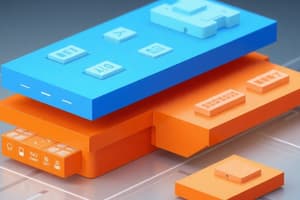Podcast
Questions and Answers
What characteristic of web systems enhances user engagement through real-time interactions?
What characteristic of web systems enhances user engagement through real-time interactions?
- Scalability
- Interactivity (correct)
- Accessibility
- Cost-Effectiveness
Which of the following best defines scalability in web systems?
Which of the following best defines scalability in web systems?
- The capacity to accommodate a growing user base (correct)
- The capability to serve static content only
- The ability to reduce costs for installations
- The ability to ensure updates are centralized
What is the primary function of the server in the request-response cycle?
What is the primary function of the server in the request-response cycle?
- Store personal user data
- Initiate user requests
- Process and respond to client requests (correct)
- Manage the client-side user interface
What are common data exchange formats used in client-server communication?
What are common data exchange formats used in client-server communication?
Which aspect of web systems allows users to access applications from any internet-connected device?
Which aspect of web systems allows users to access applications from any internet-connected device?
What advantage does the client-server model provide regarding management and development of systems?
What advantage does the client-server model provide regarding management and development of systems?
What does HTTPS add to the communication between clients and servers?
What does HTTPS add to the communication between clients and servers?
Which benefit of web systems reduces the need for complex installations and lowers maintenance costs?
Which benefit of web systems reduces the need for complex installations and lowers maintenance costs?
What is the primary role of web servers in web systems?
What is the primary role of web servers in web systems?
Which of the following describes middleware in web systems?
Which of the following describes middleware in web systems?
Which component is primarily responsible for rendering web content in a browser?
Which component is primarily responsible for rendering web content in a browser?
What technology is most commonly used for data storage and management in web systems?
What technology is most commonly used for data storage and management in web systems?
Which of the following statements about APIs is true?
Which of the following statements about APIs is true?
What is the significance of networking infrastructure in web systems?
What is the significance of networking infrastructure in web systems?
Which of the following best describes client-side components in web systems?
Which of the following best describes client-side components in web systems?
Which database technology is known for using a NoSQL format?
Which database technology is known for using a NoSQL format?
Flashcards are hidden until you start studying
Study Notes
Introduction to Web Systems
- Web systems are used to create online applications that users can access through web browsers.
- Client-side components are the parts of a web system that users directly interact with.
- Server-side components handle the backend processing and data storage.
- Networking infrastructure enables communication between clients and servers through protocols like HTTP/HTTPS.
- Middleware connects different applications and services, allowing data exchange and communication.
- APIs (Application Programming Interfaces) are sets of rules allowing software to interact with each other.
Client-Side Components
- Web browsers are software applications like Chrome, Firefox, and Safari that display web content.
- The User Interface (UI) is built using HTML, CSS, and JavaScript, and allows users to interact with web applications.
Server-Side Components
- Web servers are hardware and software that respond to requests from clients, retrieving and serving web pages or data.
- Application servers handle business logic, processing, dynamic content, and often host APIs.
- Databases store, retrieve, and manage data, often using SQL or NoSQL databases.
- Common Examples: Apache, MySQL, MariaDB, MongoDB.
- Database Use Cases:
- Non-secure: Blogs, articles, public data.
- Secure: Banking, login credentials, personal information, financial data.
Networking Infrastructure
- Facilitates communication between clients and servers.
- Protocols: HTTP (Hypertext Transfer Protocol), HTTPS (Hypertext Transfer Protocol Secure).
- HTTPS adds a layer of security through encryption.
Middleware
- Software that connects different applications or services, enabling smooth data exchange and communication.
APIs (Application Programming Interfaces)
- Define how different pieces of software communicate with each other.
- Common examples of API use cases:
- Retrieving data from a weather service.
- Integrating a social media login into a website.
- Enabling communication between a mobile app and a server.
Characteristics of Web Systems
- Scalability: They can easily adapt to growing user bases and increased data demands.
- Interactivity: Allow real-time interactions, enhancing user engagement.
- Accessibility: Can be accessed from any device with an internet connection.
- Dynamic Content: Ability to serve different content based on user interactions or inputs.
Web Architecture
- Client-Server Model: A common approach where the client sends a request to a server, which processes it and sends back a response.
Request-Response Cycle
- Client Initiation: Client sends an HTTP request (e.g., GET, POST) to the server.
- Server Processing: The server processes the request which may involve querying a database or executing business logic.
- Response Delivery: The server sends back an HTTP response containing the requested data or a status message.
Communication Protocols
- HTTP/HTTPS: Are the primary protocols for communication between clients and servers.
Data Exchange
- Data Formats: HTML, JSON, and XML are commonly used formats for exchanging information between clients and servers.
Advantages of the Client-Server Model
- Separation of Concerns: Divides user interface logic from data management and processing, resulting in easier system management and development.
Studying That Suits You
Use AI to generate personalized quizzes and flashcards to suit your learning preferences.




